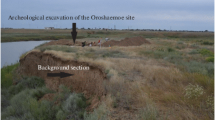Abstract
Paleosols buried under kurgans of the Bronze (end of the fourth and the third millennia BC), Early Iron (1st–3rd centuries AD), and Medieval (13th century AD) epochs have been studied on the Ilovlya River (a tributary of the Don River) terrace. The evolution of chestnut soils in the south of the Privolzhskaya Upland during the last 5000 years has been traced. It is shown that the mean weighted contents and distribution of soluble salts, gypsum, and carbonates in the soil profiles have been subjected to cyclic changes. The total microbial biomass and its trophic structure in the A1, B1, and B2k horizons of paleosols of different ages have been determined. A comparative analysis of the morphological, chemical, and microbiological data on the paleosols of different ages has been used to reconstruct the climatic dynamics for the last 50 centuries. The aridity of the climate in the studied region increased at the end of the third-the beginning of the second millennia BC and in the second and third centuries AD. The humidization of the climate took place in the 1st and in the 12th–13th centuries AD.
Similar content being viewed by others
References
A. L. Aleksandrovskii and E. I. Aleksandrovskaya, Evolution of Soils and the Environment (Nauka, Moscow, 2005) [in Russian].
N. D. Anan’eva, E. V. Blagodatskaya, D. B. Orlinskii, and T. N. Myakshina, “Methodological Aspects of Determining the Substrate-Inducing Respiration of Soil Microorganisms,” Pochvovedenie, No. 11, 72–77 (1993).
N. D. Anan’eva and G. K. Vasil’eva, “Role of the Microbiological Factor in the Decomposition of 3,4-Dichloroaniline in Soils,” Pochvovedenie, No. 5, 57–64 (1985).
E. V. Arinushkina, Handbook on the Chemical Analysis of Soils (Mosk. Gos. Univ., Moscow, 1970) [in Russian].
A. V. Borisov, Extended Abstract of Candidate’s Dissertation in Biology (Moscow, 2002).
A. V. Borisov, T. S. Demkina, and V. A. Demkin, Paleosols and Climate of Ergeni in the Bronze Age (4th–2nd Millennia B. C. (Nauka, Moscow, 2006) [in Russian].
A. N. Gennadiev, Soils and the Time: Models of Development (Mosk. Gos. Univ., Moscow, 1990) [in Russian].
A. N. Gennadiev and T. A. Puzanova, “Evolution of the Soil Cover in the Western Caspian Region during the Holocene,” Pochvovedenie, No. 2, 5–15 (1994).
V. A. Demkin, Soil Science and Archeology (Ross. Akad. Nauk, Pushchino, 1997) [in Russian].
V. A. Demkin, T. S. Demkina, A. V. Borisov, et al., “Transformation of Soils and Environmental Conditions in the Semidesert Low Volga Region within the Past 4000 Years,” Pochvovedenie, No. 3, 271–283 (2004) [Eur. Soil Sci. 37 (3), 230–241 (2004)].
V. A. Demkin, T. S. Demkina, T. E. Khomutova, et al., “Integration of Paleosol Science and Archeology in the Study of Nature and Society History,” in Soil Processes and the Spatial-Temporal Organization of Soils (Nauka, Moscow, 2006), pp. 116–140 [in Russian].
V. A. Demkin, M. V. El’tsov, A. O. Alekseev, et al., “Soil Development in the Lower Volga Area during the Historical Period,” Pochvovedenie, No. 12, 1486–1497 (2004) [Eur. Soil Sci. 37 (12), 1324–1333 (2004)].
M. I. Dergacheva, Archeological Soil Science (Ross. Akad. Nauk, Novosibirsk, 1997) [in Russian].
M. V. El’tsov, A. V. Borisov, A. S. Yakimov, et al., “Paleoecological Conditions in the Low Ilovlya River (the Volga Lowland) in the Old and Middle Ages,” in Materials on the Archeology of the Volga-Don Steppes (Volgograd, 2004), No. 2, pp. 60–86 [in Russian].
D. G. Zvyagintsev, Soil and Microorganisms (Mosk. Gos. Univ., Moscow, 1987) [in Russian].
I. V. Ivanov, Evolution of Soils in the Steppe Zone during the Holocene (Nauka, Moscow, 1992) [in Russian].
I. V. Ivanov and I. B. Vasil’ev, Humans, Nature, and Soils of Ryn Sands in the Volga-Don Interfluve during the Holocene (Intellekt, Moscow, 1995) [in Russian].
D. I. Nikitin and E. S. Nikitina, Self-purification of the Environment and Bacterial Parasites (Genus Bdellovibrio) (Nauka, Moscow, 1978) [in Russian].
Ya. G. Ryskov and V. A. Demkin, Development of Soils and Natural Environment in the Southern Ural Steppes during the Holocene (Ross. Akad. Nauk, Pushchino, 1997) [in Russian].
I. V. Sergatskov, “Burial Mounds at the Settlement of Avilov in the Low Course of the Ilovlya River,” in Materials on the Archeology of the Volga-Don Steppes (Volgograd, 2004), No. 2, pp. 4–54 [in Russian].
A. S. Skripkin, History of Volgograd Land before the Town Foundation (Volgograd, 2005) [in Russian].
L. N. Tashninova, E. V. Tsutskin, A. A. Gol’eva, et al., “Paleosols Buried under Kurgans of Different Ages within the “Black Earth” Area of Kalmykia,” Pochvovedenie, No. 2, 149–160 (2005) [Eur. Soil Sci. 38 (2), 132–142 (2005)].
E. Z. Tepper, Nocardia Microorganisms and Humus Decomposition (Nauka, Moscow, 1976) [in Russian].
T. E. Khomutova, T. S. Demkina, and V. A. Demkin, “Assessing the Total and Active Biomass of Microbial Communities in Different-Aged Paleosols Buried under Kurgans,” Mikrobiologiya 73(2), 241–247 (2004).
S. S. Chernyanskii, Extended Abstract of Candidate’s Dissertation in Geography (Moscow, 1999).
Quaternary Deposits, Geomorphology, and Recent Tectonics of the Central and Low Volga Regions (Saratov, 1982), Part 2 [in Russian].
A. S. Yakimov, Extended Abstract of Candidate’s Dissertation in Geography (Pushchino, 2004).
J. P. E. Anderson and K. H. Domsch, “A Physiological Method for the Quantitative Measurement of Microbial Biomass in Soils,” Soil Biol. Biochem. 10(3), 215–221 (1978).
A. V. Borisov, T. V. Gantchak, T. S. Demkina, and V. A. Demkin, “Fungal Mycelium Biomass in Buried and Contemporary Soils of Steppe Zone,” Eur. Soil Sci. 39(Suppl. 1) (2006).
COHORT Software, Ver. 4.21 (Costat, Berkely, CA, 1986, 1990).
D. B. Roszak and R. R. Colwell, “Survival Strategy of Bacteria in the Environment,” Microbiol. Rev. 51(3) (1987).
Author information
Authors and Affiliations
Additional information
Original Russian Text © V.A. Demkin, N.N. Kashirskaya, T.S. Demkina, T.E. Khomutova, M.V. El’tsov, 2008, published in Pochvovedenie, 2008, No. 2, pp. 133–145.
Rights and permissions
About this article
Cite this article
Demkin, V.A., Kashirskaya, N.N., Demkina, T.S. et al. Paleosol studies of burial mounds in the Ilovlya River valley (the Privolzhskaya Upland). Eurasian Soil Sc. 41, 115–127 (2008). https://doi.org/10.1134/S1064229308020014
Received:
Published:
Issue Date:
DOI: https://doi.org/10.1134/S1064229308020014




